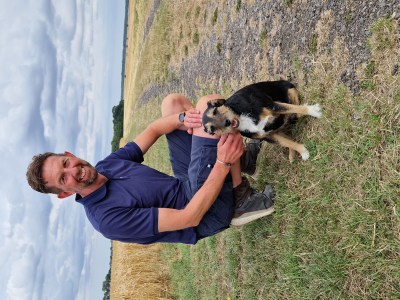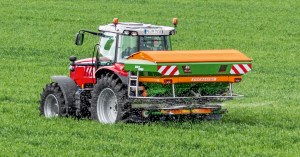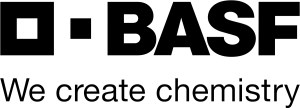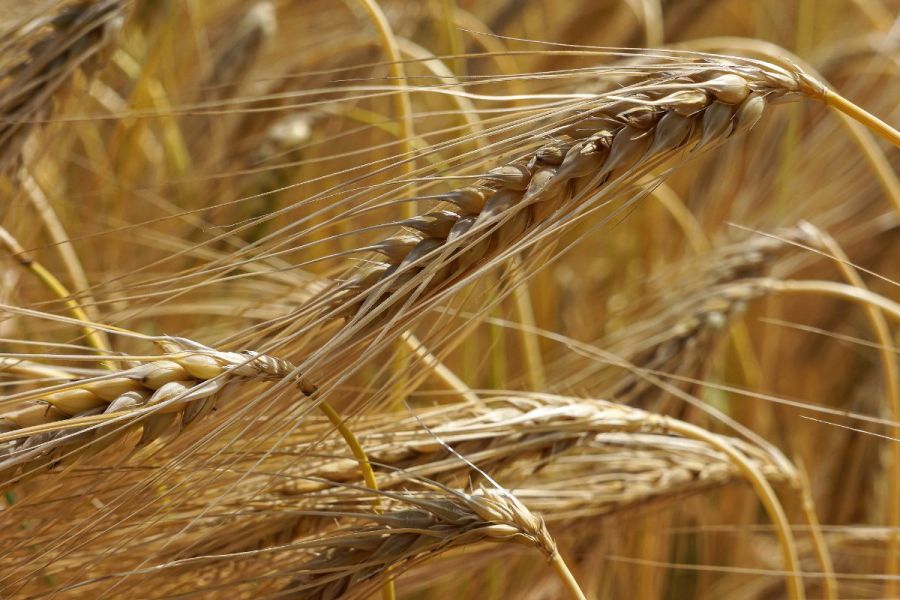After careful consideration of what was a knee-jerk reaction, a last-minute alternative to oilseed rape provides food for thought for a North Lincolnshire grower. CPM reports
“Winter barley looked the best option, not least to create an earlier and longer window for drilling oilseed rape this season.”
By Mike Abram
A knee-jerk reaction to grow winter barley when it became clear the conditions and calendar were going to threaten successful oilseed rape establishment last season has opened Pat Thornton’s eyes to the potential benefits of the crop in the rotation.

Given the relatively low disease pressure seen visually in the trial, the relatively big difference in yield between fungicide treatments was a surprise, says Pat Thornton.
According to Pat, it was going to be too dry to drill oilseed rape in August 2021 at his 150ha Low Melwood Farm, near Owston Ferry – just 20 miles east of Doncaster.
“It was obvious I was up against it, in terms of how dry it was, and looking at the calendar it was going to be a task to get a decent crop,” he explains.
“So after making the decision not to go ahead with OSR, I started looking at alternatives as there was certainly an opportunity to get something into the ground. Winter barley looked the best option, not least to create an earlier and longer window for drilling OSR this season.”
The hybrid feed variety SY Kingsbarn was chosen after discussions with a local agronomist, with its high yield potential and decent specific weight attracting him. While in variety trials, it has as wide a yield range as any winter barley variety, the range falls much higher on the graph in terms of total yield, he says.
A malting variety wasn’t an option with previous experience with spring barley grown on the farm suggesting it would be difficult to meet grain nitrogen spec.
“We grow out and out feed – it’s just not worth the risk of anything else,” comments Pat.
He followed the breeder’s recommendations for a seed rate of 200 seeds/m2, drilling the crop on 24 September. A pre-emergence herbicide stack of Liberator (diflufenican+ flufenacet) plus Defy (prosulfocarb) plus Stomp Aqua (pendimethalin) was applied across the field for blackgrass control.
In most of the field blackgrass is reasonably under control – helped with the strategies Pat has put in place, including growing spring barley – but there’s a 4ha patch where the blackgrass is more difficult, he says. “That area is a little wetter with a heavier soil type and the crop establishment wasn’t as good – perhaps 85% of the target plant population.”
Hybrid barley is sometimes marketed on the basis that its competitiveness can help swamp out blackgrass, he notes. “In hindsight it has made me wonder just what crop competition would have done without the herbicide knock it suffered, because I’d opened the canopy even more with the treatment and the crop took a backward step [in competitiveness].
“It wasn’t a disaster – blackgrass was hardly visible in June, so we’d got on top of it. In the low to moderate areas in the rest of the field, the crop did a reasonable job, although not as good at breaking the lifecycle in the way you can with spring barley.”
A dose of ammonium sulphate in early March, once there was crop growth, helped keep crop competition high for blackgrass suppression. That was followed with 60kgN/ha urea to promote and maintain tiller numbers to help maximise yield, he says. In total around 185kgN/ha was applied to the crop during the growing period.
“I was confident I could keep the crop standing so I was more thinking about maximising yield, but with the blackgrass at the back of the mind as well.”
Kingsbarn’s disease weaknesses are net blotch (rated 5 on the AHDB Recommended List) and brown rust (5). It also has moderate susceptibility to rhynchosporium (6). Brown rust was the disease most easy to find as the crop approached the key T1 (GS30-31) timing in early April, says Pat.
With little winter barley grown on the farm in the recent past, the field was a good opportunity to gain knowledge and compare key fungicide products for the crop in a BASF Real Results farm-scale tramline trial.
The comparison in the trial was between long-standing market leader Siltra Xpro (bixafen+ prothioconazole) and newer BASF treatment Tevos (pyraclostrobin+ fluxapyroxad) plus Innox (prothioconazole) at T1.
Both sets of tramlines were treated with Revystar XE (mefentrifluconazole+ fluxapyroxad) at T2. That timing suits Revystar with mefentrifluconazole’s relative strength against ramularia, suggests Aliona Jones, agronomy manager for BASF in Pat’s region. Tevos, on the other hand, is more suited to the T1 timing, with its combination of fluxapyroxad and pyraclostrobin, she says.
“Technically, it’s a mix of two very good actives in barley. The SDHI Xemium (fluxapyroxad) is an extremely strong active against rhynchosporium, while pyraclostrobin is the best strobilurin for the mutated strains of net blotch [that are difficult to control],” she explains.
“At the T1 timing, the biggest issue is usually rhynchosporium and net blotch, so for this threat and keeping disease low, the combination is perfect.
“By adding prothioconazole on top, we also cover the risk of mildew as well as adding extra control of rhynchosporium, making it a very good three-way combination.”
The co-formulated Tevos plus Innox (prothioconazole) will be widely available as a co-pack option for the coming season, she notes.
In the trial, which used standard commercial rates of Siltra Xpro (0.45 l/ha) and Tevos (0.4 l/ha) plus Innox (0.4 l/ha), disease remained visually low during the season, says Pat.
A disease assessment was due to be made on 28 June, but like many crops last summer, warm dry weather in late June caused rapid senescence so that the trial couldn’t be assessed. Despite that, as the majority of the crop senesced rapidly Pat thinks the Tevos-treated tramlines hung on a little longer. “You could start to see slight differences in the treatments,” he notes.
That difference became more evident when the combine went through. The yield data was analysed using ADAS Agronomics, which helps clean the data by removing headlands, any anomalous combine runs when the header might not be full or spans both treatments and locally extreme data points. The data is also corrected for offsets created by changes in combine direction.
Statistical analysis is then used to estimate treatment effects and associated standard errors. In this case, the farm standard Siltra programme yield was measured as 11.05 t/ha – higher than the true average due to the exclusion of headlands, while the Agronomics analysis estimated that the BASF treatment increased yield by 1.24 t/ha.
With the variation in the yield data, ADAS is 90% confident that difference ranges from 0.43 t/ha to as high as 2.05 t/ha, with 1.24 t/ha as the best estimate, says ADAS research consultant Susie Roques, who manages Agronomics trials.
In this case, the statistical model suggested the yield benefit in the trial was unlikely to have been the result of underlying soil variation, she confirms.
The analysis also gives growers a guide, based on the trial result, of the probability of different levels of yield response. Susie says the analysis’ best estimate (1.24 t/ha) has a 50% probability of occurring, with higher yield responses becoming more unlikely, and lower yield responses more likely (see table).
“If we think our estimation of the treatment effect is 1.24 t/ha, then we’re pretty sure it is over 0.5 t/ha – hence the 93% probability,” she says.
The table is intended to be used in conjunction with relative costs of different treatments to determine the likelihood for an economic benefit, she explains.
While given the relatively low disease pressure seen visually in the trial, that kind of difference was perhaps a surprise, although Pat says he definitely saw a noticeable difference in yield as he was combining the field.
Aliona says it wasn’t the only result like this, however. “We had a few trials which were similar, and in all the barley trials I think growers are convinced of the value of Tevos treatment.”
But what was behind the yield increase? Aliona suggests both the physiological and disease control benefits from pyraclostrobin and fluxapyroxad could have been playing a part in the dry spring and summer period.
“In barley, physiological effects are even more important than in wheat, for example,” she claims. “It’s one of those crops where you only have to breathe on it and it starts yellowing. So keeping stress out is extremely important.”
That’s particularly important for ramularia, she points out. “Keeping the crop clean as long as possible delays the switch in the ramularia pathogen from being a benign fungus in the barley plant into a pathogen.
“The moment the crop gets stressed, the switch happens as ramularia is already in 80% of barley plants, so keeping the crop clean from disease is important as that will cause stress, and that’s obviously a strength of both pyraclostrobin and fluxapyroxad.”
Fluxapyroxad also has a physiological effect that will help the crop during period of dry weather, she notes. “It’s helps regulate the opening and closing of the stomata in the plant and controlling water loss, so if there is drought Xemium has this positive physiological effect.”
If the effect of the treatment was to keep the crop greener for longer, as Pat thinks, that will also have contributed to extra grain fill and higher yields.
Despite the success of the winter barley crop, Pat hasn’t planted any for the coming season. The early harvest gave him an extra two weeks over wheat for a good entry into OSR, and with rain forecast in mid-August he was able to drill the crop just before it came.
“We were able to spread some sewage cake and get it drilled on 10 August, and it’s looking really well – I think the sewage helped keep flea beetle off, and by the time we got to August bank holiday and peak migration it was well-established and big enough to withstand attack,” he says.
That success has also got him considering whether winter barley should return next season to help give the best entry into OSR, he says. “It was a bit of a kneejerk reaction to put it in, and another one to not grow it.
“But now having seen the data, it will come back, particularly if we don’t get the opportunity to put OSR in after wheat in good time. In the autumn we don’t know the OSR would come up as well as it did, so we’ve got a one-year lag.”
Being able to continue with OSR in the rotation has other benefits including stretching the rotation for his other main break crop, winter beans, which would benefit from a longer break.
Pat says his YEN results highlighted that there was very little in the way of limiting factors for the crop, which was why it yielded so well and took advantage of the free resources (eg water, sunlight, etc). But blackgrass would potentially stop the crop being able to take advantage of those things because of either its innate competitiveness or the check from herbicides – hence wanting to grow it where blackgrass was under control.
“So maybe I was too quick to act and I can see barley coming back. The only caveat is that I would need to be confident on those fields around the blackgrass, because I think the secret from these results was putting the barley crop in the field and not putting anything in its way to stop it. It had all the free resource it wanted, and captured it all, with the fungicides we applied giving it a little extra boost to take the yields to those levels,” he concludes.
Variable rate nitrogen interest from xarvio trial

xarvio was used to produce a powerzone map that split a field of winter wheat into five different zones and nitrogen was variable applied using in-season biomass data.
Pat’s interest in the potential to variably apply fertiliser has been piqued after taking part in a joint BASF and Amazone trial using BASF’s digital platform xarvio on the farm.
Insight gained from satellite-sourced normalised difference vegetation index (NDVI) imagery and yield data was used to create a xarvio powerzone map that split a winter wheat field into five different zones.
Those zones were used to drill the field using seed rates that varied by 15-20% using tined and disc Amazone drills, and to variably apply nitrogen using in-season biomass data.
“It was an interesting exercise,” Pat says. “My view is that on a farm of our scale we don’t really want to mess about too much with variable seed rates.
“But with the way fertiliser prices are going, variable rate fertiliser was interesting in terms of the potential savings with the xarvio maps. Over the course of the season, there seemed to be a levelling up effect across the field and took out some of the range of results we’ve seen in previous years.”
Future Real Results plans
Next year’s Real Results trials are still in the planning, but Pat would be interested in investigating winter bean yields.
“Last year, the top one third of the pods basically died when it came hot. But the top one-third is where the profit is in my opinion. We’re establishing them differently now using shallower cultivations than the plough, pest control isn’t too bad, but we need to be pushing yields.
“We can’t be growing the standard 5-6 t/ha that we were 20 years ago; it needs to be 8.75 t/ha to start competing with other break crops. So yes, I’d like to look a bit harder at how I can keep that top third greener longer and take them through to harvest.”
The Real Results Circle

BASF’s Real Results Circle farmer-led trials are now in their sixth year. The initiative is focused on working with more than 50 farmers to conduct field-scale trials on their own farms using their own kit and management systems. The trials are all assessed using ADAS’ Agronomics tool which delivers statistical confidence to tramline, or field-wide treatment comparisons – an important part of Real Results.
In a continuation of this series we follow the journey, thinking and results from farmers involved in the programme. The features also look at some other related topics, such as environmental stewardship and return on investment.
We want farmers to share their knowledge and conduct on-farm trials. By coming together to face challenges as one, we can find out what really works and shape the future of UK agriculture.
To keep in touch with the progress of these growers and the trials, go here.
This article was taken from the latest issue of CPM. For more articles like this, subscribe here.




